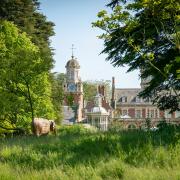His work has always been in danger of over exposure. The Suffolk landscapes of John Constable have appeared on more biscuit tins, jigsaw puzzles and tea trays than any other artist, but as Andrew Clarke discovers, when seen on a gallery wall, they remain as fresh as the day they were painted

How many Hay Wains did Constable paint? How many versions of The Leaping Horse are there? The answer is not straightforward. It maybe two, or three, or four. Art curator at London’s V&A Museum, Dr Mark Evans, has brought together multiple versions of the classic paintings and elements of those paintings to form the basis of a new exhibition at the V&A – Constable: The Making of a Master.
But, it’s more than a simple retrospective. It’s the most extensive exhibition of his work to go on show for the past 50 years. It pulls together work from the V&A, The National Gallery and Tate Britain as well as items from private collections to the largest collection of Constable’s work, under one roof, in living memory. There’s so much on display that the work fills seven galleries at the V&A. But, that’s not all.
The exhibition serves as a form of artistic archaeology because it also displays Constable’s sketchbooks, which he took out on his long country walks around East Bergholt. These delicate books filled with swiftly executed drawings and handwritten notes turn Constable the Artist into Constable the Man.
Dr Evans explains: “This exhibition seeks to show his finished works alongside his sketches and his studies in context – set against the world in which they were created. We show him alongside his heroes: people like Rubens, Claude and Ruisdael. We follow him from what Constable called his: ‘careless childhood on the River Stour’ which made him an artist, to the end of his life to the great Salisbury Cathedral painting of 1831.”

The exhibition displays not only his great exhibition pictures including The Hay Wain, The Leaping Horse, Dedham Vale, The Cornfield and Boatbuilding at Flatford Mill but also all the preparatory sketches and earlier works. It also displays for the first time a previously unseen oil sketch of brick kilns on Hampstead Heath which was discovered on the back of another canvas, Branch Hill Pond, Hampstead.
Some of his great six foot exhibition paintings were in development for a decade or longer. He would frequently revisit his sketchbooks created on his walks in Suffolk and pull out elements from past drawings, to be reworked and inserted into these vast masterpieces.
“When Constable was painting his six-foot exhibition paintings he would always paint a full-sized oil sketch.”
Dr Evans says that there is some credence to the belief that Constable could be seen as a prophet of impressionism. Certainly to modern eyes, Constable’s studies appear to be livelier, more dynamic, more impressionistic than his highly detailed, rather more composed, finished works.
When viewed side by side at the V&A, I actually preferred the studies to the finished pictures. With the studies you come into contact with Constable himself as he throws paint around the canvas. There is a sense of energy and urgency that’s missing from those great and much studied formal exhibition pictures.
It’s great to stand back and look at the acknowledged masterpieces in one room and then tour the rest of the exhibition and spot details in earlier works which are also displayed in other areas of the exhibition. His cloud studies and flower paintings are rarely seen and remind you what a wonderful observer he was and a superb draughtsman.
Also on display are his copies of works by past masters. All through his life he would copy works by acknowledged masters as a way of understanding how they achieved effects and how they utilised colour, composition and oil paint.
In a world where contemporary art can be an empty room with a crack in the floor, a stuffed shark, or an ethereal audio-visual installation why do we all still revere the 19th century landscape artist John Constable?
According to Dr Evans the answer is simple. “It’s because he had the ability to capture a moment and make it transcend time.”
It’s the timeless quality of his work that makes Constable one of the great sons of Suffolk. His work remains fresh and when you see it up close in a gallery you understand why he is credited with inventing the English landscape.
The exhibition is a revelation.
Constable: The Making of a Master runs at the V&A until January 11



























